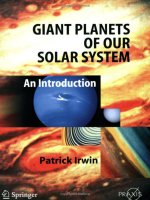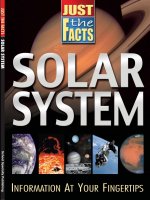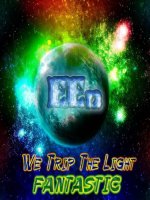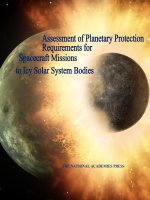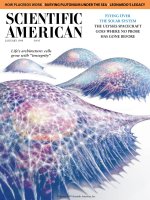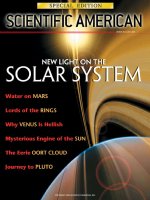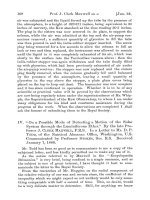solar system lessons 2-3
Bạn đang xem bản rút gọn của tài liệu. Xem và tải ngay bản đầy đủ của tài liệu tại đây (8.34 MB, 20 trang )
Solar Solar
SystemSystem
Lessons 2–3Lessons 2–3
CXECA08ARD505_LLR_CVb1 3CXECA08ARD505_LLR_CVb1 3 2/22/06 11:41:08 AM2/22/06 11:41:08 AM
Copyright © by Harcourt, Inc.
All rights reserved. No part of this publication may be reproduced or transmitted in
any form or by any means, electronic or mechanical, including photocopy, recording,
or any information storage and retrieval system, without permission in writing from the
publisher.
Requests for permission to make copies of any part of the work should be addressed to
School Permissions and Copyrights, Harcourt, Inc., 6277 Sea Harbor Drive, Orlando,
Florida 32887-6777. Fax: 407-345-2418.
HARCOURT and the Harcourt Logo are trademarks of Harcourt, Inc., registered in the
United States of America and/or other jurisdictions.
Printed in the United States of America
ISBN-13: 978-0-15-349197-9
ISBN-10: 0-15-349197-3
1 2 3 4 5 6 7 8 9 10 179 15 14 13 12 11 10 09 08 07 06
If you have received these materials as examination copies free of charge, Harcourt
School Publishers retains title to the materials and they may not be resold. Resale of
examination copies is strictly prohibited and is illegal.
Possession of this publication in print format does not entitle users to convert this
publication, or any portion of it, into electronic format.
CXECA08ARD505_LLR_CVb1 4CXECA08ARD505_LLR_CVb1 4 2/22/06 11:41:43 AM2/22/06 11:41:43 AM
Visit The Learning Site!
www.harcourtschool.com
Orlando
Austin
New York
San Diego
To ronto
London
Lesson 2
What Makes Up the Solar System? . . . . . . . . . . . . . . . . . 2
Lesson 3
What Holds the Moon and Planets in Place? . . . . . . . . . . 8
The Solar
System
Lessons 2–3
1
CXECA08ARD5052-3_BLR.indd 1CXECA08ARD5052-3_BLR.indd 1 2/25/06 12:45:36 PM2/25/06 12:45:36 PM
VOCABULARY
solar system
planet
satellite
asteroid
comet
Sun
Mercury
Venus
Earth
Mars
Jupiter Saturn Uranus
Neptune
Pluto
Our solar system includes
nine planets. They revolve
around the sun.
Earth is a planet. It is a body
that revolves around a star.
What Makes What Makes
Up the Solar Up the Solar
System?System?
2
2
2
CXECA08ARD5052-3_BLR_01 2CXECA08ARD5052-3_BLR_01 2 2/22/06 3:02:34 PM2/22/06 3:02:34 PM
An asteroid can leave craters
when it hits Earth.
A satellite revolves around
Earth. They can be artificial or
natural.
3
A comet can have a tail millions of kilometers
long.
CXECA08ARD5052-3_BLR_03 3CXECA08ARD5052-3_BLR_03 3 2/23/06 1:08:19 PM2/23/06 1:08:19 PM
4
READING FOCUS SKILL
MAIN IDEA AND DETAILS
The main idea is what the text is mostly about.
Details are pieces of information about the main idea.
Look for details about the inner and outer planets.
The Inner Planets
A solar system is made up of a star and the objects that
revolve around it. These objects can be planets, satellites, or
other objects. A
planet
is a body that revolves around a star. A
satellite
is a body that revolves around a planet.
Our solar system includes nine planets. There are four inner
planets. The inner planets are Mercury, Earth, Venus, and
Mars. They are all rocky and dense.
What is one detail about the inner planets?
Mars
Venus
Earth
Mercury
The inner planets: Mercury,
Earth, Venus, and Mars
CXECA08ARD5052-3_BLR_01 4CXECA08ARD5052-3_BLR_01 4 2/22/06 3:02:47 PM2/22/06 3:02:47 PM
5
The Outer Planets
Beyond the inner planets are the five outer planets. In order
from the sun, they are Jupiter, Saturn, Uranus, Neptune, and
Pluto.
Jupiter is the largest planet. Saturn is best known for its
rings. Uranus has many moons and rings. Neptune has the
strongest winds in the solar system. Pluto is small and rocky.*
What is one detail about the outer planets?
Jupiter
Saturn
Uranus
Neptune
Pluto
The outer planets: Jupiter, Saturn,
Uranus, Neptune, and Pluto
*In 2006, the International Astronomical Union defined a planet as a body
that orbits the sun, is spherical, and is large enough to clear its orbit. They
reclassified Pluto as a “dwarf planet,” because it is not large enough to
clear its orbit.
CXECA08ARD5052-3_BLR.indd 5CXECA08ARD5052-3_BLR.indd 5 10/23/06 3:06:12 PM10/23/06 3:06:12 PM
5
The Outer Planets
Beyond the inner planets are the five outer planets. In order
from the sun, they are Jupiter, Saturn, Uranus, Neptune, and
Pluto.
Jupiter is the largest planet. Saturn is best known for its
rings. Uranus has many moons and rings. Neptune has the
strongest winds in the solar system. Pluto is small and rocky.
What is one detail about the outer planets?
Jupiter
Saturn
Uranus
Neptune
Pluto
The outer planets: Jupiter, Saturn,
Uranus, Neptune, and Pluto
CXECA08ARD5052-3_BLR_01 5CXECA08ARD5052-3_BLR_01 5 2/22/06 3:03:40 PM2/22/06 3:03:40 PM
6
Asteroids and Comets
Asteroids
are chunks of rock too small to be called planets.
Asteroids are located in the area between Mars and Jupiter.
They make up the asteroid belt.
Meteors are other small pieces of rock that travel through
space. When meteors hit Earth’s atmosphere, they usually
burn up.
A
comet
is a ball of ice, rock, and frozen gases that orbits
the sun. A comet may pass close to the sun and then swing
out to the edge of the solar system.
What is one detail about asteroids?
What are comets made of?
CXECA08ARD5052-3_BLR_03 6CXECA08ARD5052-3_BLR_03 6 2/23/06 1:08:47 PM2/23/06 1:08:47 PM
7
Complete this main idea statement.
1. A ______ ______ is made up of a star and all the
planets and other objects that revolve around that star.
Complete these detail statements.
2. Our ______ ______ includes nine planets.
3. There are ______ inner planets.
4. There are ______ outer planets.
Review
Review
CXECA08ARD5052-3_BLR_03 7CXECA08ARD5052-3_BLR_03 7 2/23/06 1:09:40 PM2/23/06 1:09:40 PM
VOCABULARY
orbit
elliptical
inertia
gravity
The Earth’s orbit is around
the sun.
The orbit of Mars is elliptical,
or oval-shaped.
What Holds What Holds
the Moon and the Moon and
Planets in Planets in
Place?Place?
8
3
3
CXECA08ARD5052-3_BLR_01 8CXECA08ARD5052-3_BLR_01 8 2/22/06 3:05:39 PM2/22/06 3:05:39 PM
9
Inertia keeps a ball at
rest or moving.
Gravity helps keep roller coaster cars on
the track.
CXECA08ARD5052-3_BLR_01 9CXECA08ARD5052-3_BLR_01 9 2/22/06 3:05:43 PM2/22/06 3:05:43 PM
10
READING FOCUS SKILL
CAUSE AND EFFECT
A cause is something that makes another thing
happen. An effect is the thing that happens.
Look for the cause of a planet staying a certain
distance from the sun.
The Path of a Planet Around the Sun
An
orbit
is the path that a body follows as it revolves around
another body. The sun is at the center of the solar system.
Planets move in
elliptical
orbits around the sun. An elliptical
orbit is shaped like a flattened circle. Because the orbits are not
circular, each planet is closer to the sun at certain times.
What is the effect of an orbit’s shape on the planet’s
distance from the sun?
A Planets travel around the sun in elliptical orbits.
CXECA08ARD5052-3_BLR_01 10CXECA08ARD5052-3_BLR_01 10 2/25/06 12:04:52 PM2/25/06 12:04:52 PM
11
What Holds the Moon and Planets in Orbit?
What keeps the planets moving in their orbits?
Inertia
keeps an object moving in a straight line at a steady
speed. The object will keep going unless pushed or pulled by
some force.
Gravity
is the force that pulls objects toward Earth. If there
were no gravity, Earth would travel forever, in a straight line
through space. Gravity causes a pull between the mass of a
planet and the mass of the sun.
Gravitational force plus inertia produces a planet’s orbit.
The sun’s constant pull changes a planet’s direction. It causes
the paths of planets and the moon to be curved.
What causes planets to stay in their orbits?
The Earth and the Moon
Earth and its moon move
together around the sun.
Because the moon is always
orbiting Earth while the
Earth-moon system orbits the
sun, the moon’s path around
the sun is a series of loops.
Inertia and gravity keep the
moon in a nearly circular
orbit around Earth.
CXECA08ARD5052-3_BLR_03 11CXECA08ARD5052-3_BLR_03 11 2/23/06 1:10:05 PM2/23/06 1:10:05 PM
12
Phases of the
Moon
The way the moon looks
from Earth changes every
day. Half of the moon is
always lit by the sun. How
much you see depends
on the moon’s phase. A
moon phase is the shape
the moon seems to have
as it orbits Earth.
When Earth is between
the moon and the sun,
you see a full moon. When
the moon is between
Earth and the sun, you
can’t see the moon. This
is the new moon. Starting
with the new moon, you
see more and more of the
moon each day until you
see the full moon.
What causes the
moon to appear
bright?
What are the phases of
the moon?
waning gibbous
third quarter
waning cresent
CXECA08ARD5052-3_BLR_01 12CXECA08ARD5052-3_BLR_01 12 2/25/06 12:05:00 PM2/25/06 12:05:00 PM
13
new moon
first quarter
second quarter
waxing gibbous
full moon
CXECA08ARD5052-3_BLR_01 13CXECA08ARD5052-3_BLR_01 13 2/22/06 3:07:35 PM2/22/06 3:07:35 PM
14
Gravity in Space
Astronauts in the space shuttle orbit close to Earth. The
shuttle is so close that gravity is almost as strong there as it is
on Earth. Astronauts appear to be weightless because inertia
and gravity are balanced.
The shuttle engines are off but the shuttle moves forward.
That is inertia. Earth’s gravity pulls on the shuttle as it moves
forward. The astronauts inside are really free-falling as the
shuttle moves forward.
What causes astronauts to appear weightless
in space?
CXECA08ARD5052-3_BLR_01 14CXECA08ARD5052-3_BLR_01 14 2/25/06 12:05:11 PM2/25/06 12:05:11 PM
15
Complete these cause and effect statements.
1. The ______ of a planet is due to gravitational
attraction between the sun and the planet.
2. ______ and ______ cause planets to stay in their
orbits.
3. The moon appears bright because of the ______ .
Review
Review
CXECA08ARD5052-3_BLR_15 15CXECA08ARD5052-3_BLR_15 15 2/27/06 12:14:20 PM2/27/06 12:14:20 PM
16
GLOSSARY
asteroid [AS
•
ter
•
oyd] A piece of rock and metal that orbits
the sun.
comet [KAHM
•
it] A ball of ice, rock, and frozen gases that
orbits the sun.
elliptical [ee
•
LIP
•
tih
•
kuhl] Oval-shaped.
gravity [GRAV
•
uh
•
tee] The attraction that pulls objects toward
Earth.
inertia [in
•
ER
•
shuh] The property of matter that keeps an
object at rest or moving in a straight line.
orbit [OR
•
bit] The path that one body takes in space as it
revolves around another body.
planet [PLAN
•
it] A body that revolves around a star.
satellite [
SAT
•
uh
•
lyt] A body in space that orbits a larger
body.
solar system [
SOH
•
ler
SIS
•
tuhm] A star and all the planets and
other objects that revolve around it .
CXECA08ARD5052-3_BLR_01 16CXECA08ARD5052-3_BLR_01 16 2/22/06 3:08:12 PM2/22/06 3:08:12 PM
Think About the Reading
1. What can you do to help you remember what you have learned
in this chapter?
2. What questions do you have after reading this book? How can
you find the answers to your questions?
Hands-On Activity
Use clay to model two or more planets.
1. Label the planets.
2. Label the planets as inner or outer planets.
School-Home Connection
Explain to a family member what you have read about the
solar system. Ask the family member to name the planets in
our solar system.
CXECA08ARD505_LLR_CVb1 5CXECA08ARD505_LLR_CVb1 5 2/22/06 11:41:44 AM2/22/06 11:41:44 AM

